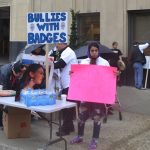Justice for Jackie
On January 28th, Jacqueline Salyers, a woman from the Puyallup tribe, was shot by two officers from the Tacoma police department during an attempt to arrest her boyfriend, Kenneth Wright Jr., who did not belong to the tribe.
The police had a warrant for Wright’s arrest. Around midnight, they noticed Wright in the passenger seat of a parked car and began to approach. Salyers was in the driver’s seat. What came next is disputed.
According to police, as they approached the car from the front, Salyers accelerated towards them and they shot at her to protect themselves. Witnesses, on the other hand, tell a different story, claiming that the police began shooting at the car from the back before announcing their arrival. These claims are supported by Associated Press photographs showing that the window on the driver’s side was shot out, which could not have happened if the car was driving straight toward the officers.
The Tacoma police department is currently investigating the case but little information has been released so far. However, there is a clear conflict of interest here: the police cannot be trusted to investigate themselves, since people within the same organization may be unwilling to believe ill of or punish each other. As a result, Salyers’ family is calling for an independent investigation by the Department of Justice.
This is not an isolated incident. Native Americans have been, and remain, victims of violent racism. A 2014 study by the Center on Juvenile and Criminal Justice finds that Native Americans are the race most likely to be killed by police. While they only make up 0.8% of the population, they make up 1.9% of police killings, meaning they are killed at more than twice the rate at which they are represented in the population.
Tacoma police do claim to be making an effort to prevent abuses. On their website, they say they are “committed to community policing” and plan to increase “cultural competency” and “undoing institutional racism.” Furthermore, they are attempting to implement Campaign Zero, a plan for police reform designed by the Black Lives Matter organization. On the surface, at least, this looks like a good step.
Despite these attempts, however, change comes slowly and not everyone is going to be on board with reforms. Also, conflicts of interest can still subconsciously override political beliefs and hinder investigations. The fact that such an abuse of power could still take place despite attempts at reform only makes the situation more frightening, proving that racism still runs deeply throughout American society and that regulations alone fail as a solution.
Though body cameras have gained popularity as a way of monitoring police activity, they have not yet been put into use in Tacoma. They do plan to use them at some point in the future, but according to Christopher Gregory, leader of Tacoma’s chapter of the NAACP, “they’re dragging their feet.” As a result, no video was captured of the incident. However, one bystander was able to take a photo showing Salyers’ body being dragged to the police car. This corroborates witnesses’ reports that she was dragged to the police car, driven a short distance, then dragged out again onto the sidewalk.
Police spokesperson Loretta Cool maintained that the officers had helped Salyers, calling medics to the scene, though Salyers died before they arrived. After the news organization Indian Country Today Media Network told her they knew the body had been moved, Cool stated, “I cannot say why the officers did what they did in this particular case. I believe the suspect, in the area with a rifle, would dictate moving to a safer location to administer medical aid.”
Wright, the suspect they had sought out in the first place, was not arrested until 17 days later. This brings into question whether the police even bothered to try arresting him after shooting Salyers. Witnesses agree that he fled with a rifle, something that could possibly have been prevented if the officers had not spent so much time attacking Salyers.
To add insult to injury, Salyers was found to be pregnant during an autopsy that was performed on her. Her uncle, James Rideout, expressed anger that the family was not told ahead of time that the autopsy would take place or informed of the pregnancy when her body was released for burial.
While burying her body, Salyers’ family noted injuries that bring the police report into question.
According to her cousin, Gina Gilman, Salyers was shot in the right temple and right arm, and another bullet had clipped her left hand. Her right arm was also broken, but not as the result of a gunshot.
Because of the need to continually search for more information on the death, the tribe has been unable to grieve according to traditional customs, says Rideout. “Normally, at this point, we would have put away the photos and mementoes of the person and after a year would have a giveaway to honor them,” he explains. “But this time, we have to constantly relive, rehash, discuss, figure out everything about Jackie’s death.”
While there are still many unknown variables, things currently look very suspicious. Witness reports, as well as evidence from Salyers’ car, from photos, and from her body, do not line up with the official police report. The lack of action makes it seem even more likely that foul play was involved. An independent investigation would allow for an unbiased look into the circumstances surrounding Salyers’ death. It is crucial that the Department of Justice respond to calls to investigate this incident, in order to discover what truly happened.







